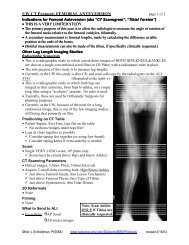Ankle and Foot 47 - Department of Radiology - University of ...
Ankle and Foot 47 - Department of Radiology - University of ...
Ankle and Foot 47 - Department of Radiology - University of ...
Create successful ePaper yourself
Turn your PDF publications into a flip-book with our unique Google optimized e-Paper software.
<strong>47</strong> <strong>Ankle</strong> <strong>and</strong> <strong>Foot</strong> 2213 <strong>47</strong><br />
A B C<br />
D<br />
E<br />
Figure <strong>47</strong>-9. The 10 ankle tendons are illustrated as colored lines drawn over three-dimensional CT images. A, Anterior view <strong>of</strong> the anterior<br />
tendons: anterior tibial (AT; red), extensor hallucis longus (EHL; green), <strong>and</strong> extensor digitorum longus (EDL; blue). B, Posterior view <strong>of</strong> the<br />
posterior tendons: Achilles (Ach; light blue) <strong>and</strong> plantaris (yellow). Also labeled are the medial pole <strong>of</strong> the navicular (N) <strong>and</strong> the sustentaculum tali<br />
(ST). C, Posterolateral view <strong>of</strong> the lateral tendons: peroneus brevis (PB; dark purple) inserting into the base <strong>of</strong> the fifth metatarsal, <strong>and</strong> peroneus<br />
longus (PL; light purple) wrapping under the cuboid. Medial (D) <strong>and</strong> posterior (E) views <strong>of</strong> the medial tendons, illustrating the “Tom, Dick, <strong>and</strong><br />
Harry” mnemonic: the posterior tibial (PT; red) wraps under the medial malleolus <strong>and</strong> inserts on the medial pole <strong>of</strong> the navicular (N); the flexor<br />
digitorum longus (FDL; blue) runs behind the PT, under N, <strong>and</strong> out to the second to fifth toes; <strong>and</strong> the flexor hallucis longus (FHL; green) runs<br />
behind the talus, wraps under the sustentaculum tali (ST), crosses under the FDL at the master knot <strong>of</strong> Henry, <strong>and</strong> passes between the two great<br />
toe sesamoids (white arrows), inserting on the distal phalanx.<br />
tendon in axial cross section, except the Achilles<br />
tendon. 42<br />
The anterior tendons extend, uncrossed, over the ankle<br />
joint <strong>and</strong> foot (see Fig. <strong>47</strong>-9A). The anterior tibial is the<br />
most medial <strong>of</strong> the three anterior tendons. It extends along<br />
the medial aspect <strong>of</strong> the great toe tarsometatarsal joint to<br />
insert on the plantar aspect <strong>of</strong> the base <strong>of</strong> the first metatarsal<br />
<strong>and</strong> the adjacent medial cuneiform bone. The extensor<br />
hallucis longus is the middle <strong>of</strong> the three anterior tendons,<br />
proceeding straight to its insertion at the dorsal base <strong>of</strong> the<br />
great toe distal phalanx. The most lateral <strong>of</strong> the three anterior<br />
ankle tendons is the extensor digitorum longus. At the<br />
level <strong>of</strong> the midfoot, the extensor digitorum longus fans<br />
out into four separate tendon slips, which, in turn, proceed<br />
along the forefoot to insert at the dorsal bases <strong>of</strong> the second<br />
through fifth middle <strong>and</strong> distal phalanges. 21,31<br />
Whereas the anterior tibial <strong>and</strong> extensor digitorum<br />
longus tendons can be followed over a series <strong>of</strong> axial<br />
images (see Fig. <strong>47</strong>-10), it is common to lose visualization<br />
<strong>of</strong> the extensor hallucis longus tendon as it curves anterior<br />
to the midfoot (see Fig. <strong>47</strong>-10C). This is in part due to<br />
“magic-angle” effects. 7 It is important not to misinterpret<br />
this lack <strong>of</strong> visualization as a rupture <strong>of</strong> the extensor hallucis<br />
longus tendon, a condition that is exceedingly rare.<br />
Ch0<strong>47</strong>-A05375.indd 2213<br />
9/9/2008 5:33:31 PM
















